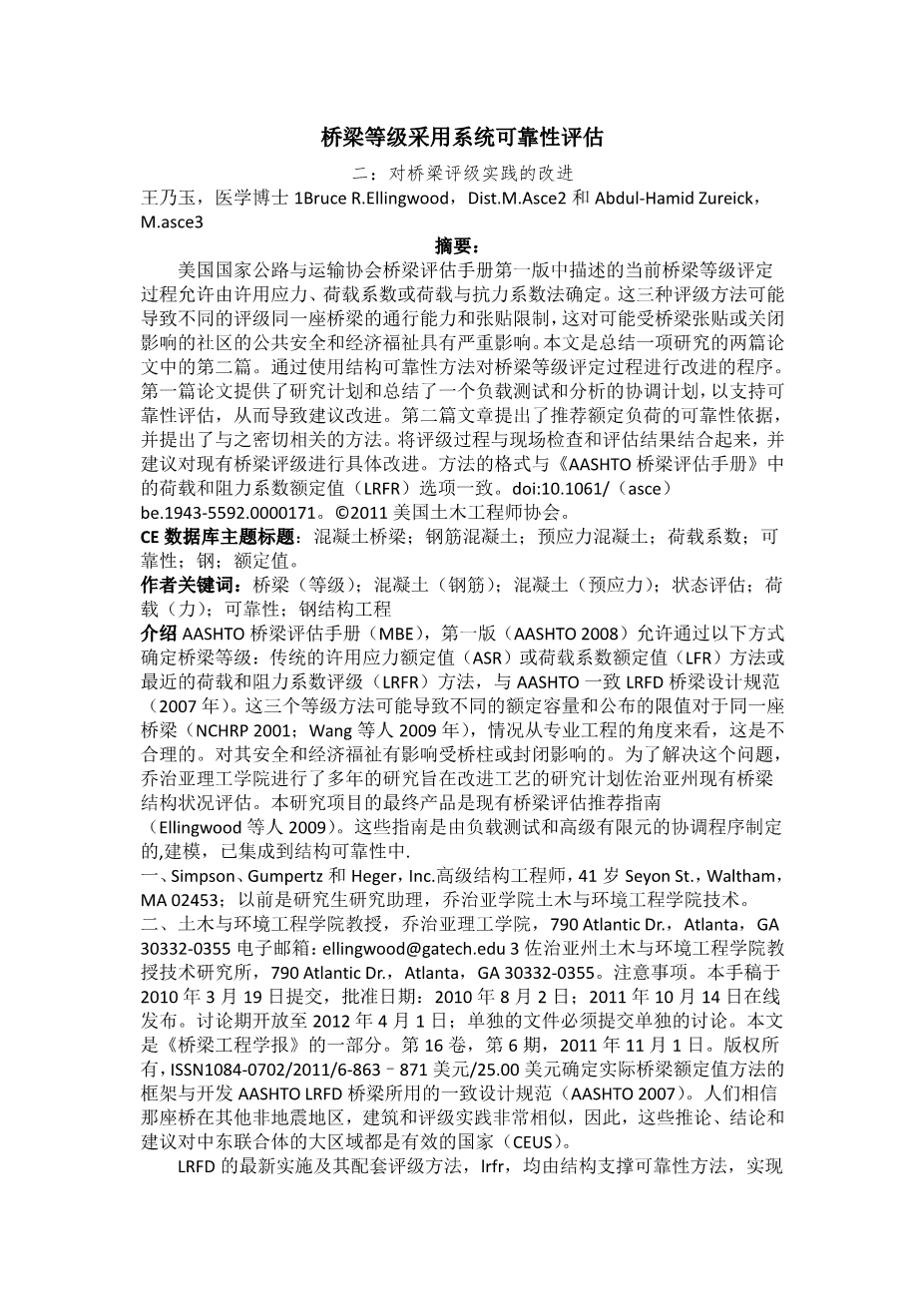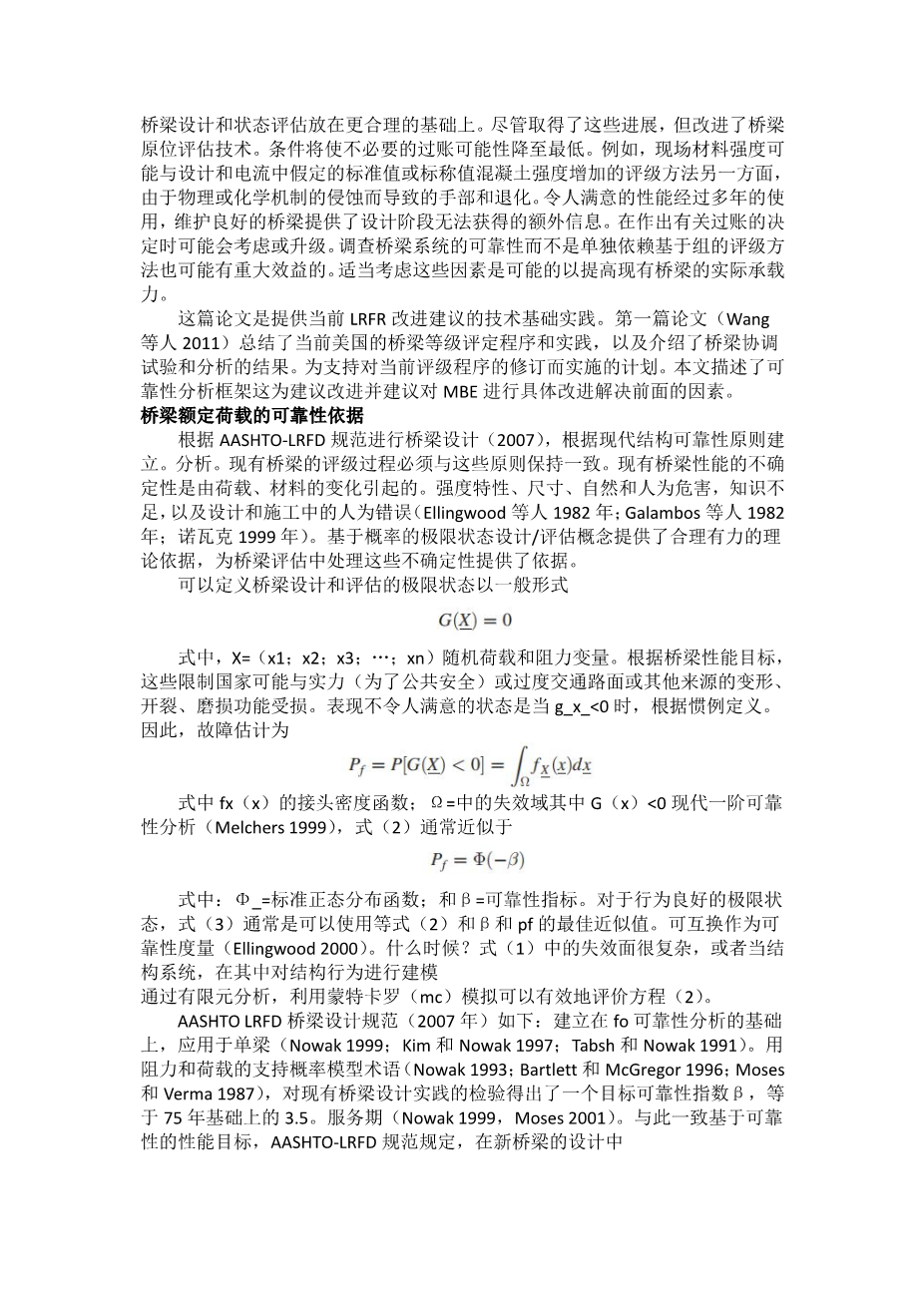Bridge Rating Using System Reliability Assessment.
II: Improvements to Bridge Rating Practices
Naiyu Wang, M.ASCE1; Bruce R. Ellingwood, Dist. M.ASCE2; and Abdul-Hamid Zureick, M.ASCE3
Abstract: The current bridge-rating process described in AASHTO Manual for Bridge Evaluation, First Edition permits ratings to be determined by allowable stress, load factor, or load and resistance factor methods. These three rating methods may lead to different rated capacities and posting limits for the same bridge, a situation that has serious implications with regard to public safety and the economic well- being of communities that may be affected by bridge postings or closures. This paper is the second of two papers that summarize a research program to develop improvements to the bridge-rating process by using structural reliability methods. The first paper provided background on the research program and summarized a coordinated program of load testing and analysis to support the reliability assessment leading to the recommended improvements. This second paper presents the reliability basis for the recommended load rating, develops methods that closely couple the rating process to the results of in situ inspection and evaluation, and recommends specific improvements to current bridge-rating methods in a format that is consistent with the load and resistance factor rating (LRFR) option in the AASHTO Manual for Bridge Evalu- ation. DOI: 10.1061/(ASCE)BE.1943-5592.0000171. copy; 2011 American Society of Civil Engineers.
CE Database subject headings: Concrete bridges; Reinforced concrete; Prestressed concrete; Load factors; Reliability; Steel; Ratings.
Author keywords: Bridges (rating); Concrete (reinforced); Concrete (prestressed); Condition assessment; Loads (forces); Reliability; Steel; structural engineering.
Introduction
The AASHTO Manual for Bridge Evaluation (MBE), First Edition (AASHTO 2008) allows bridge ratings to be determined through the traditional allowable stress rating (ASR) or load factor rating (LFR) methods or by the more recent load and resistance factor rating (LRFR) method, which is consistent with the AASHTO LRFD Bridge Design Specifications (2007). These three rating methods may lead to different rated capacities and posted limits for the same bridge (NCHRP 2001; Wang et al. 2009), a situation that cannot be justified from a professional engineering viewpoint and has implications for the safety and economic well-being of those affected by bridge postings or closures. To address this issue, the Georgia Institute of Technology has conducted a multiyear research program aimed at making improvements to the process by which the condition of existing bridge structures in Georgia are assessed. The end product of this research program is set of recommended guidelines for the evaluation of existing bridges (Ellingwood et al. 2009). These guidelines are established by a co- ordinated program of load testing and advanced finite-element modeling, which have been integrated within a structural reliability
1Senior Structural Engineer, Simpson, Gumpertz, and Heger, Inc., 41 Seyon St., Waltham, MA 02453; formerly, Graduate Research Assistant, School of Civil and Environmental Engineering, Georgia Institute of Technology.
2Professor, School of Civil and Environmental Engineering, Georgia Institute of Technology, 790 Atlantic Dr., Atlanta, GA 30332-0355 (corresponding author). E-mail: ellingwood@gatech.edu
3Professor, School of Civil and Environmental Engineering, Georgia Institute of Technology, 790 Atlantic Dr., Atlanta, GA 30332-0355.
Note. This manuscript was submitted on March 19, 2010; approved on August 2, 2010; published online on October 14, 2011. Discussion period open until April 1, 2012; separate discussions must be submitted for indi- vidual papers. This paper is part of the Journal of Bridge Engineering, Vol. 16, No. 6, November 1, 2011. copy;ASCE, ISSN 1084-0702/2011/6- 863–871/$25.00.
framework to determine practical bridge-rating methods that are consistent with those used to develop the AASHTO LRFD Bridge Design Specifications (AASHTO 2007). It is believed that bridge construction and rating practices are similar enough in other non- seismic areas to make the inferences, conclusions, and recommen- dations valid for large regions in the central and eastern United States (CEUS).
The recent implementation of LRFD and its companion rating method, LRFR, both of which have been supported by structural reliability methods, enable bridge design and condition assessment to be placed on a more rational basis. Notwithstanding these ad- vances, improved techniques for evaluating the bridge in its in situ condition would minimize the likelihood of unnecessary posting. For example, material strengths in situ may be vastly different from the standardized or nominal values assumed in design and current rating practices attributable to strength gain of concrete on one hand and deterioration attributable to aggressive attack from physi- cal or chemical mechanisms on the other. Satisfactory performance of a well-maintained bridge over a period of years of service pro- vides additional information not available at the design stage that might be taken into account in making decisions regarding posting or upgrading. Investigating bridge system reliability rather than solely relying on component-based rating methods may also be of significant benefit. Proper consideration of these factors is likely to contribute to a more realistic capacity rating of existing bridges. This paper is the second of two companion papers that provide the technical bases for proposed improvements to the current LRFR practice. The first paper (Wa
剩余内容已隐藏,支付完成后下载完整资料


英语译文共 13 页,剩余内容已隐藏,支付完成后下载完整资料
资料编号:[609397],资料为PDF文档或Word文档,PDF文档可免费转换为Word


